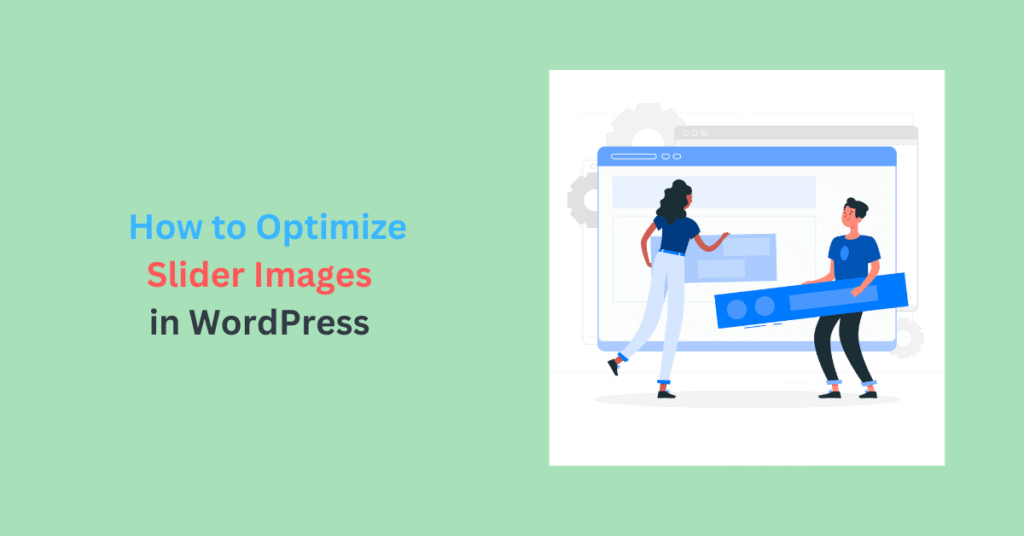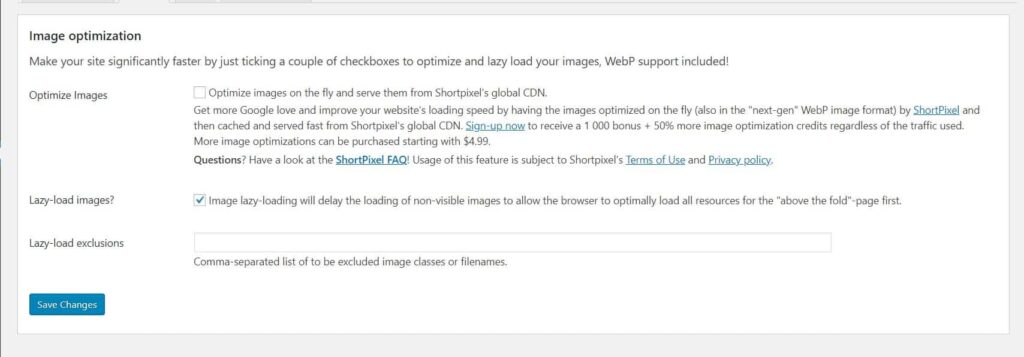How to Optimize Slider Images in WordPress

Visuals, including slider images, are an integral part of user engagement. WordPress site owners turn to visual elements like sliders, to engage visitors, portray the brand’s image, and convey messages with one glance.
Using sliders enhances the visual appeal of a website. Slider images tell a compelling story while highlighting important featured content.
To truly harness the power of slider images, the key is optimization. Optimized sliders are captivating and load lightning-fast. They have a long-lasting impact on site visitors while reducing strain on your servers.
Here’s how to optimize your images to responsive and user-friendly sliders while saving on hosting costs.
What Is a Slider?
A slider is a web page design element that presents content items such as images in a slideshow layout. Slide transitions are either automatic after a few seconds or when the user clicks on the next.
You can place sliders on different areas of your website based on their purpose and your site’s layout. Types of sliders to use on your WordPress website include:
- Carousel: These sliders display many images at once for users to navigate through. They are most efficient for product galleries.
- Background: This places slider images behind areas with content you want the user especially interested in.
- Block: Designers use this slider type to create content blocks. They can use WordPress block plugins like Gallery, Cover, and Custom Block. The content block displays one slide at a time. The slide contains combined elements like text, images, videos, and buttons.
- Standard: It’s a simple slideshow that displays several images but only one at a time.
- Showcase: This slider type focuses on one image at a time but allows a peek at other images in the collection. WordPress site owners often use them on their home and landing pages to immediately draw a visitor’s attention to offers or important messages.
Site designers can create, optimize and add beautiful and responsive sliders to their WordPress websites using various slider plugins. You can succeed at this even without prior coding skills.
Why Optimize Slider Images in WordPress?
Optimized slider images are a step towards peak site performance. Here’s how optimizing slider images enhances your WordPress site’s performance:
Faster Loading Speeds
With optimized slider images you get a reduced file size while still preserving image quality. Small file sizes load faster so sites experience better visitor retention. Slow-loading pages cause greater bounce rates which negatively affects SEO.
Improved User Experience
Optimized slider images load swiftly and are eye-catching, allowing users to engage with your website content uninterrupted. This means longer session durations and sites get higher conversion rates in increased subscriptions, sales, or user interaction.
Compatibility and Mobile Responsiveness
With more than 50% of users accessing websites on mobile devices now, screen size limitations really affect user experience. Optimized slider images work well on different devices and screen sizes without display issues or broken layouts.
Seamless device adaptability ensures flawless content delivery which improves your search results rankings.
Reduced Bandwidth Usage
Images use up to over 60% of the internet’s bandwidth. A smaller file size means images consume less bandwidth during loading. The strain on servers reduces so hosting providers cut down on operational costs for maintenance and updates.
Most web hosting platforms charge according to bandwidth usage. Websites running on a lower bandwidth save on hosting costs, especially those receiving high traffic.
Choosing the Right WordPress Slider Plugin
When choosing a slider plugin you should consider factors like customization, website layout, ease of use, budget and responsiveness.
Finding a seamless slider plugin to handle all your optimization needs can be stressful. To help, we have hand-picked the following three slider plugins that are excelling in optimizing sliders for WordPress websites.
1. Smart Slider 3
Smart Slider 3 is a powerful and user-friendly WordPress plugin. It features a drag-and-drop builder interface to arrange your images, layer them, and design your customized slider.
The plugin affords many customizable slider navigation options including Autoplay, Arrows, Bullets, Thumbnails, Bars, and Shadows. Sliders created using Smart Slider 3 are 100% responsive on all device types.
The plugin also integrates well with many page builders like Elementor and Beaver Builder. The free version has 14 customizable slider templates for two slider types. The pro plan, requiring a one-time payment of 49$, gives access to 120+ templates for four slider types.
On the other hand, the premium plan has all pro features but with premium page builder support. These extensive customization features make it possible for anyone to create dynamic and interactive sliders.
2.MetaSlider
MetaSlider is a free slider plugin with an intuitive interface that designers can use to create sliders without writing any code. The plugin integrates with WordPress, allowing you to seamlessly drag and drop images directly from your media manager.
It also lets you preview the sliders before uploading them to your website so you can fine-tune them to get optimal slideshows.
To activate MetaSlider on WordPress, scroll within the ‘plugins’ section on your dashboard’s sidebar, click ‘Add New’, input ‘MetaSlider’, and select ‘Install Now’. When the plugin activates, it appears on the sidebar.
3. Soliloquy
What makes this plugin optimal is that besides its slide scheduler, it has an SEO-friendly shortcode HTML markup. This markup makes your slides more discoverable by search engines.
Soliloquy has other unique features like lightbox support. Its notable carousel mode rotates images in the slider according to user clicks, to increase interactivity.
With the pro version, you also get access to dynamic sliders. These sliders retrieve images from external sources like blogs and social media. They add them to your shortcode or template tag turning your images into responsive WordPress sliders.
Other Techniques for Optimizing WordPress Slider Images
Use the Correct Image Size
A constant image size ensures visual consistency. This contributes to a well-designed, high-performance, and user-friendly website.
WordPress uses four default image dimension limits:
- Thumbnails, at 150px by 150px
- Medium-size images at 300px width and height
- Large sizes at 1024px square
- Full-sized photos maintain their original size.
The ShortPixel Adaptive Images plugin determines image dimensions appropriate to your visitor’s screen size.
It then resizes and properly crops your slider images. This ensures they load fast and are seamless on that device type. This plugin works for images in all file formats, alongside JSS/CSS files.
Lazy Load the Images
Lazy-loading reduces the initial load time of web pages by delaying sliders from loading until they are in your user’s viewport. This technique helps save on bandwidth costs. Data used across your network is lower, which makes images load faster with minimal downtime.
WordPress plugins integrated with ShortPixel, like Autoptimize, will automatically lazy load optimized slider images during uploading.

Autoptimize adds the “loading=lazy” attribute to the ‘<img>’ HTML image tags. This attribute instructs all image slides to only load when they are on display.

You can use this lazy-loading attribute on WordPress without a plugin by updating your website to a 5.4 version or higher. Also, enable image lazy-loading at your browser level by using the attribute and setting it to lazy.
Use a CDN for Image Delivery
A Content Delivery Network(CDN) is a global network of edge servers that optimize image delivery to end-users. When you use a CDN on your website, it copies your slider images and caches them in data centers close to popular internet exchange points.
When a user visits your site, the CDN distributes your optimized sliders across edge servers nearest to the visitor’s IP address. They load fast with high resolution at an appropriate size for every device type.
Caching slider images in CDNs has countless benefits including faster loading pages, reduced server strain, lower bandwidth usage, and better search result rankings. Examples of popular CDNs suitable for WordPress websites include Cloudflare, Sucuri, and Bunny.net.
Designers can use Shortpixel to access images in a CDN and then optimize them according to different end-users’ viewports.
Compare Image File Formats for Slider Images
Comparing the different image file formats available online lets you know which to use in different situations. The four main web file formats for images are
- PNG: PNG is suitable for lossless compression. The images have a higher resolution and a larger file size than JPG files.
- JPG: This format can undergo high compression producing files with a very small size. It is suitable for images with complex color gradients.
- GIF: The format is best for simple animations. Its 8-bit format restricts it to images with limited color palettes and detail.
- WebP: This next-generation format delivers both lossy and lossless techniques for images. Sliders in the WebP format are 12% smaller than PNGs.
Plugins like the Shortpixel Image Optimizer generate images in next-generation WebP/AVIF formats for WordPress websites.
Images in these formats load better on popular browsers like Safari, Google Chrome, and Firefox than the JPGs and PNGs.
Compress the Images
High-resolution images have a larger file size that can affect a webpage’s loading speed. Compressing a slider image reduces its file size with minimal loss in quality.
Site owners can use various compression plugins such as Shortpixel to compress slider images on Wordpress. This plugin supports three compression types for all file formats.
The plugin also converts older PNG/JPG file formats to modern WebP/AVIF formats for higher compression efficiency.
Image SEO Optimization
Search engines rely on page load speed as a key ranking factor. Slow-loading websites bring an unsatisfactory user experience. Search engines are therefore automated to rank them lower on SERPs.
Adding optimized images that load faster to content, improves the general user experience. This pushes your website to a higher rank on search engines.
The following are some ways you can optimize images on your website to maximize SEO:
- Include alt tags: Alt tags are a text description of the image content. Use alt tags to tell search engines how to list your slider images accurately.
- Using captions: Captions with high-ranking keywords make your site more visible, which increases the overall traffic.
- Use original images: Stock photos make a website look unoriginal so visitors lose interest fast. This can cause increased bounce rates. Original images are custom-made and 100% optimizable to best reflect your brand.
Speed Test Your Slider Images
Speed testing slider images evaluates the execution and loading speed of the sliders on a website. This ensures that the sliders do not slow down your website’s overall loading time.
You can test site performance and loading speeds using various online tools like GTmetrix, WebPageTest, and Google PageSpeed Insights.
Final Thoughts
Optimizing slider images for your WordPress site offers many perks including, better search rankings, longer session durations and higher conversion rates. A responsive WordPress site is more engaging, which lowers the overall bounce rate.
Embrace these techniques and start experimenting with different slider plugins to resize, compress, and modernize your sliders. Most of all, use CDNs for storage and lazy load your images. Include alt texts and captions to make search engines rank your site content.